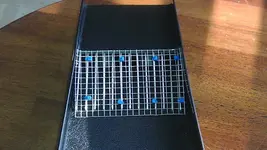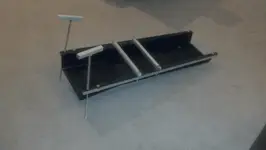UncleMatt
Bronze Member
- Joined
- Jul 14, 2012
- Messages
- 2,389
- Reaction score
- 2,535
- Golden Thread
- 0
- Location
- Albuqerque, NM / Durango, CO
- Detector(s) used
- Garrett Infinium & Gold Bug II, Bazooka Super Prospector Sluice
- Primary Interest:
- All Treasure Hunting
Okay, I built the pump found here
GOLD RECOVERY PUMP
It looks interesting enough that I am modding one in a few ways. I am going to be using it as a dredge pump, so it feeds a hose with a check valve in the boomer box GG style, instead of on the unit itself as in the original plans. But my main focus has been on the collection capabilities of the area of the pump below the plunger under the intake/outake. It is a perfect area for a fluid bed trap, but I am trying to increase the amount of sediment suspension by increasing water flow. However, it already has fairly effective ways of removing the heavies from the sediments in suspension.
As the sediment/ water pass the first check valve, and enters the main pump body, water velocity drops as the 1 1/2" hose enters the 4" internal area of the pump body. Some heavies fall out right there, and are swept over the edge into the holding area by water flow. Then the water is being pulled and turned up 90 degrees from the main flow direction. Lighter sediments can make this 90 degree turn, but I wager that most remaining heavies can't. Subsequently they fall out of the main water flow up into the cylinder, and fall into the main collection area at the base of the pump. Then as the pump plunger descends, water is forced downward toward the collection area, and makes another 90 turn out of the pump to the exit hose. Here again, this time with the help of gravity, sediments in suspension are subject to forces which allow the lighter stuff to make the turn, but the heavies cannot. And this time momentum carries them directly down into the collection area at the base.
Concern: Much like in a bazooka sluice, I could see the collection area rapidly filling with sediments and rocks. In the bazooka fluid trap there are tubes feeding constant water flow into the bed to keep particles suspended, and to keep the light stuff exiting. No such feature on this pump. So what is to prevent the collection area from just filling up with junk and then ceasing to function as a collector? Entrainment might pull a lot of light stuff out of there as the water flows by above it, but I would like to figure out a way to feed water to the base of it so there would be internal flow upwards through the collection area at the base of this pump. It might be as simple as installing a 1/2" pipe inside the pump under the plunger, or a hose along the outside for the same purpose. Or perhaps an internal grizzly. I even have something on the drawing board for another pump inside the main one just for fluidizing the bed. Feedback appreciated.
This pump was originally designed for sniping and crack cleaning, not running a sluice or serving as a fluid bed trap, just be aware. I have been looking at maybe building one from transparent pipe to see what is going on internally, but haven't found a good source for transparent PVC pipe yet. I also plan on doing some cold weather testing with a couple of bins of water and sediment with lead weights as test gold. When I get that going, I will post video.
GOLD RECOVERY PUMP
It looks interesting enough that I am modding one in a few ways. I am going to be using it as a dredge pump, so it feeds a hose with a check valve in the boomer box GG style, instead of on the unit itself as in the original plans. But my main focus has been on the collection capabilities of the area of the pump below the plunger under the intake/outake. It is a perfect area for a fluid bed trap, but I am trying to increase the amount of sediment suspension by increasing water flow. However, it already has fairly effective ways of removing the heavies from the sediments in suspension.
As the sediment/ water pass the first check valve, and enters the main pump body, water velocity drops as the 1 1/2" hose enters the 4" internal area of the pump body. Some heavies fall out right there, and are swept over the edge into the holding area by water flow. Then the water is being pulled and turned up 90 degrees from the main flow direction. Lighter sediments can make this 90 degree turn, but I wager that most remaining heavies can't. Subsequently they fall out of the main water flow up into the cylinder, and fall into the main collection area at the base of the pump. Then as the pump plunger descends, water is forced downward toward the collection area, and makes another 90 turn out of the pump to the exit hose. Here again, this time with the help of gravity, sediments in suspension are subject to forces which allow the lighter stuff to make the turn, but the heavies cannot. And this time momentum carries them directly down into the collection area at the base.
Concern: Much like in a bazooka sluice, I could see the collection area rapidly filling with sediments and rocks. In the bazooka fluid trap there are tubes feeding constant water flow into the bed to keep particles suspended, and to keep the light stuff exiting. No such feature on this pump. So what is to prevent the collection area from just filling up with junk and then ceasing to function as a collector? Entrainment might pull a lot of light stuff out of there as the water flows by above it, but I would like to figure out a way to feed water to the base of it so there would be internal flow upwards through the collection area at the base of this pump. It might be as simple as installing a 1/2" pipe inside the pump under the plunger, or a hose along the outside for the same purpose. Or perhaps an internal grizzly. I even have something on the drawing board for another pump inside the main one just for fluidizing the bed. Feedback appreciated.
This pump was originally designed for sniping and crack cleaning, not running a sluice or serving as a fluid bed trap, just be aware. I have been looking at maybe building one from transparent pipe to see what is going on internally, but haven't found a good source for transparent PVC pipe yet. I also plan on doing some cold weather testing with a couple of bins of water and sediment with lead weights as test gold. When I get that going, I will post video.
Last edited:





 I'm ready to buy a Prospector too and sell my other 8 sluice boxes, haha.
I'm ready to buy a Prospector too and sell my other 8 sluice boxes, haha.